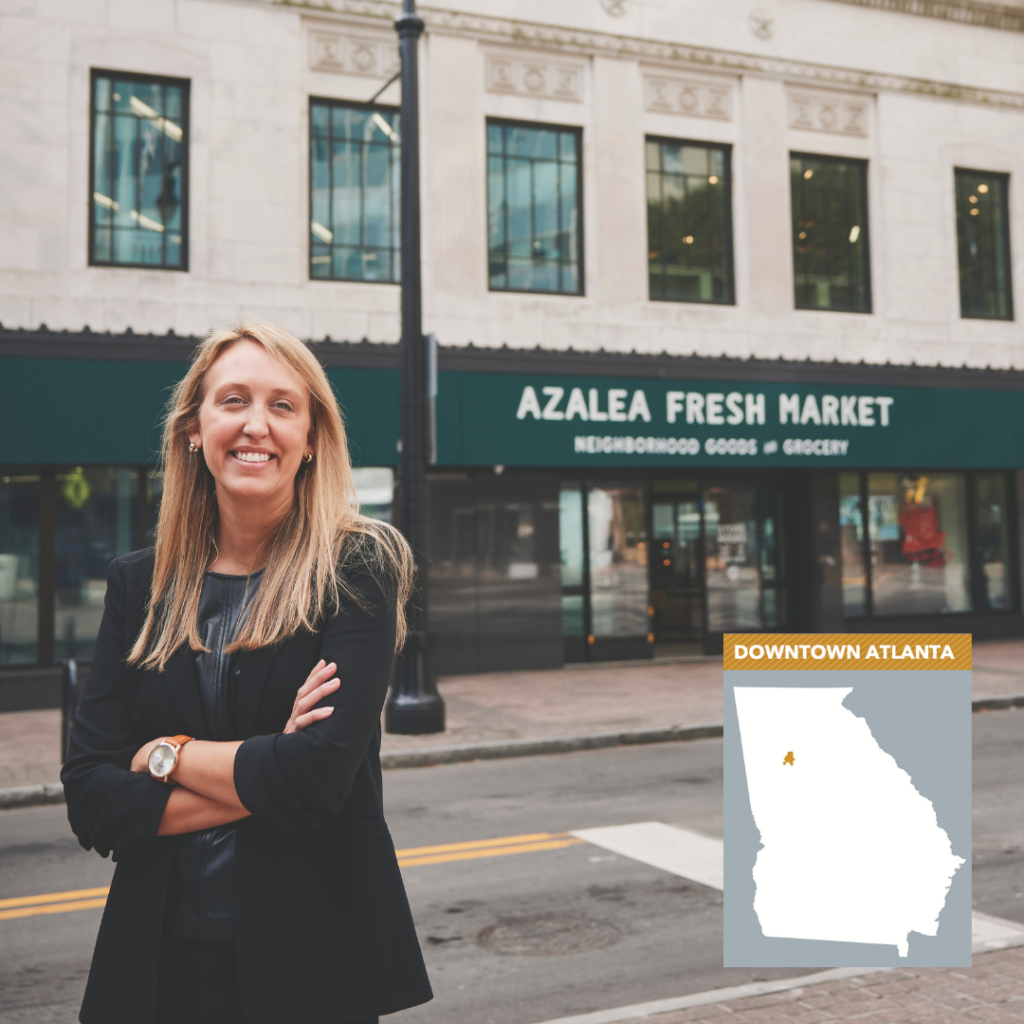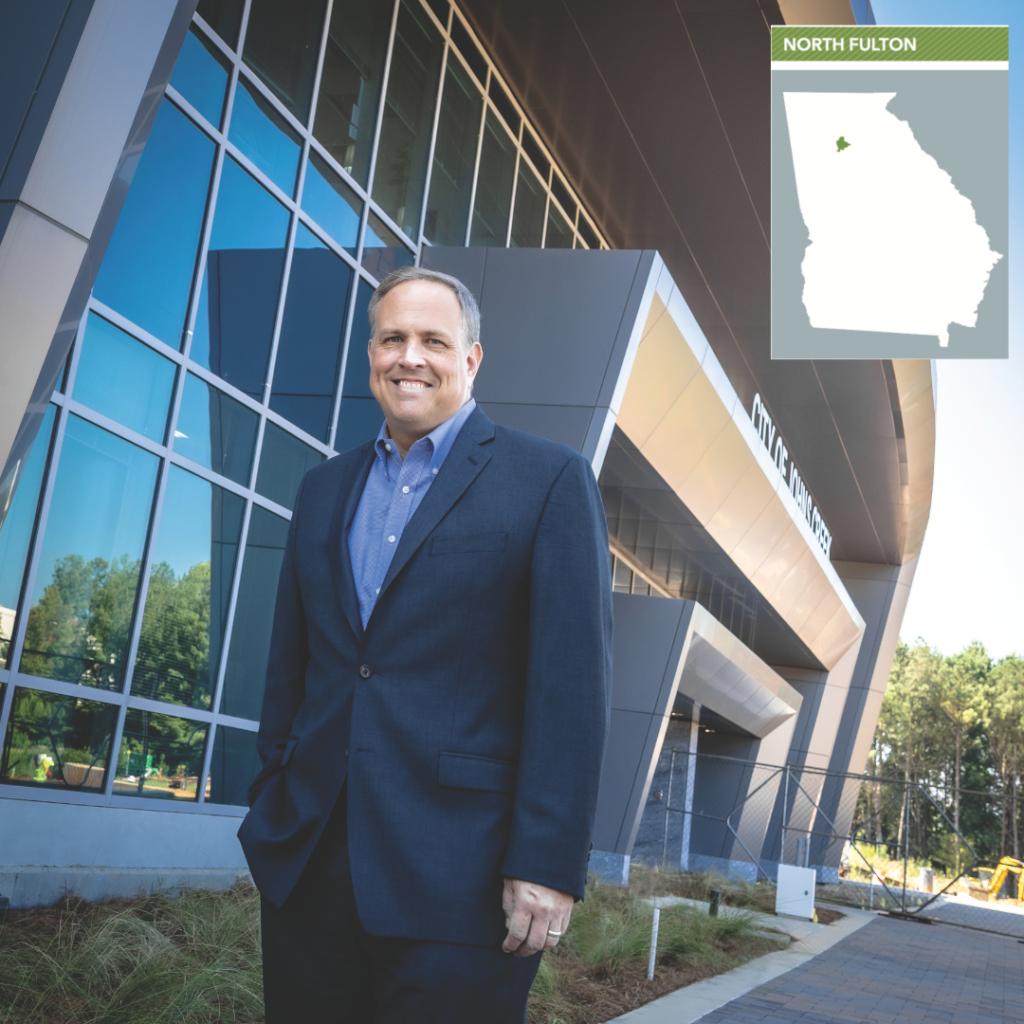South Metro Atlanta | Sophisticated Growth
Industry, development and manufacturing.
South Metro Atlanta is in the midst of a transformation.
 The area has long been known for warehousing and logistics, but a convergence of factors is opening new avenues for growth and development in movie studios as well as residential, retail and commercial development. And local leaders see further potential for change.
The area has long been known for warehousing and logistics, but a convergence of factors is opening new avenues for growth and development in movie studios as well as residential, retail and commercial development. And local leaders see further potential for change.
Fulton County Director of Economic Development Samir Abdullahi says political leaders are getting ahead of the curve by connecting with the development community and setting real standards for what they hope to do in the area.
Growth has become a fact of life in a region that includes South Fulton along with Coweta, Fayette, Clayton, Henry and Spalding counties.

Emphasizing Nature: Chris Montesinos, Chattahoochee Hills economic development director, at Cochran Mill Park, photo Woodie Williams.
South Metro is diverse and, in many places, quite different from the larger Metro Atlanta region.
“What we are seeing is a continuation of dynamic strong growth in the South Metro region,” said Michael Hightower, managing partner of the Collaborative Firm, an Atlanta-based strategic consulting practice.
New projects are sprouting up in every county. From mixed-use developments, movie studios and sports facilities to warehouses, data centers and a bevy of company relocations, the region is seeing the fruits of long years of touting its assets both locally and across the country.
“The exposure and the ability to tell [the region’s] stories to those who have not seen the Southside has helped create those opportunities for further growth,” said Hightower. Continuing this process of education “is going to be a major part of the agenda for the future,” he added.
Global Destination
Development in the region is driven by both economic forces and the political will of local citizens.
In Chattahoochee Hills, which encompasses more than 60,000 acres of mostly undeveloped land, some 3,000 residents are keen on controlling growth and ensuring that they preserve picturesque woodlands, rolling hills and farms. The city owns Cochran Mill Park, which has 800 woodsy acres of fields, streams, waterfalls and the ruins of three historic mills.
Many residents are leery of too much growth coming too fast, and local leaders are careful to ensure that any development fits the city’s emphasis on the natural, says Chris Montesinos, Chattahoochee Hills economic development director.
Many look to the master-planned Serenbe community, with its walkable neighborhoods and sustainable development carved out of woodlands and pastures, as a model. It currently has about 650 residents.
“It’s a global destination for ecotourism, but also quality eco-development,” says Abdullahi.
Located at the southwestern end of Fulton County, the community is developing a new retail, lodging and resort district.
The project is expected to include a “world-class” destination hotel and wellness resort, a second resort hotel, shopping, office space and an aging-in-place wellness campus.
The plan is getting help in the form of a $298 million bond inducement from the Development Authority of Fulton County. Work is expected to begin in 2024.
Also relatively new to the area is Terra School at Serenbe. Initially a Montessori school for younger children, it has since expanded, now serving around 200 students from preK through high school. The school prides itself on having a learner-driven environment and maximizing access to nature.
The Mightiest Engine
While Serenbe may feel like a wooded retreat, just 23 miles northeast is Hartsfield-Jackson Atlanta International Airport, a mighty economic engine that drives much of the local economy and attracts companies seeking to locate or expand in the surrounding region. As the world’s busiest airport, it channels $34.8 billion in economic impact to Metro Atlanta and more than 63,000 jobs on-site, making it the state’s largest employer, according to the Aerotropolis Atlanta Alliance.
“Industrial has a big presence” near the airport, says Shannon James, president and CEO of the Aerotropolis Atlanta Alliance, a public-private partnership working to improve the regional economic competitiveness of the area around Hartsfield-Jackson.
But more recently, “from a development perspective, we are finding a big interest in residential development,” he says. “We do need density. More rooftops have been a big discussion across our region because we know [retail and other business development] follows rooftops and our area doesn’t have a whole lot of rooftops.”
More housing is starting to spring up. In Morrow, real estate investment and development firm Carter is developing Story Mt. Zion, a 300-unit multifamily residential community, according to James. Construction is underway with the final units scheduled to be finished by the end of the year.
In Hapeville, South City Partners recently opened its Signal development near the airport and Porsche’s North American headquarters. This mixed-use project includes apartments, townhomes and retail space.
“We’re showing folks that you can bring quality developers and development to the airport area,” says James.
Much-needed affordable housing is also getting a boost with the construction of the Diamond in downtown College Park, according to James.
“It’s creative lofts with an affordable housing component, and it’s literally next to [the] MARTA station,” he says.
The 60-unit development will include just 10 market-rate apartments, according to reports.
In the Spotlight
Chattahoochee Hills and Forest Park are grabbing pieces of Georgia’s massive film industry.
The industry generated $8.55 billion in fiscal year 2022 alone, according to a recent study by Olsberg SPI, a consulting firm that specializes in the “screen sector.”
Bouckaert Farm – an 8,000-acre facility whose rustic beauty, rolling hills and spacious pavilion make it an ideal location for weddings and equestrian events alike – is also becoming a favorite for film production. Marvel, Paramount, HBO and Netflix have all used Bouckaert’s facilities in Chattahoochee Hills to shoot everything from blockbuster movies to independent films and television series.
In Forest Park, Blue Star Studios is now open for bookings, as it continues expanding on its $180 million, 53-acre campus. The finished facility will house around 600,000 square feet of production and office space and 14 stages ranging from 5,000 to 40,000 square feet. The facility is being built in the historic Fort Gillem headquarters building.
The studio is the latest addition to the decommissioned military base, which has been transformed into a 1,168-acre master-planned logistics center. It is now home to a wide variety of companies, including a Kroger logistics center.
Partnerships for Industrial Parks
If you leave Forest Park and head about 35 miles south, you’ll be in Spalding County, which in some ways, is a victim of its own success. That’s because its industrial parks are full, which has prompted local leaders to shift direction.
“We’re basically back to being out of land again,” explains David Luckie, executive director of the Griffin-Spalding Development Authority. “So our business model is changing. In the past, we have owned, developed and operated all of the industrial parks in Spalding County. And now, we will be working with private developers on industrial parks.”
The county has about 10 privately owned industrial tracts, and “we’ll be partnering with [the owners] on what will end up being new industrial parks, except we just won’t own them,” says Luckie. “As long as we continue landing projects, we’re happy no matter how they get here.”
The county-run industrial parks may be full, but some are getting unique features. The Lakes at Green Valley is getting a new aquatic center on land deemed unsuitable for industrial development. The 21,000-square-foot facility, which will accommodate competitive swimming events, is set to open later this year, according to Luckie.
“We’re also now working on a retail commercial component to the park,” says Luckie, who says he hopes “to attract services that would be of interest to the residents … like restaurants, a dry cleaner [and a] medical office.”
Growth Spurs New CID
Groundbreakings are a tangible sign of the success of Henry County’s economic development efforts. Renewal by Andersen, the window replacement division of Andersen Corp., recently turned soil on its first manufacturing facility in Georgia at The Cubes at Locust Grove.
The new facility is projected to host 900 new jobs as part of $420 million capital investment at the industrial park, according to Josh Fenn, executive director of the Henry County Development Authority.
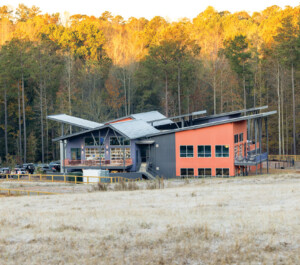

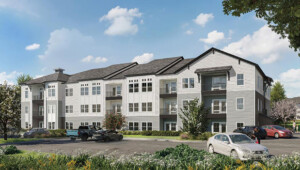
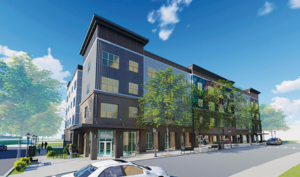
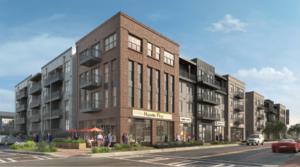
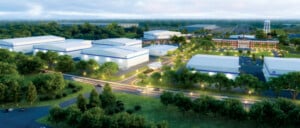
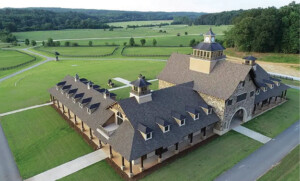
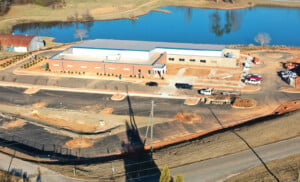
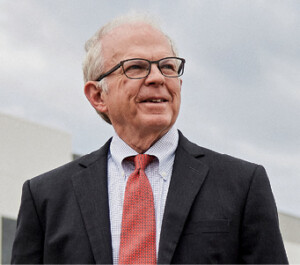

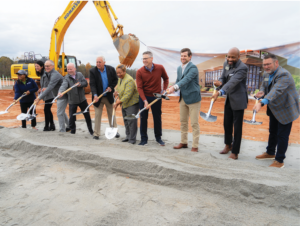
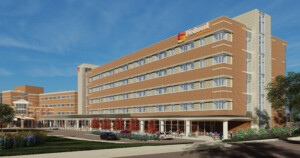

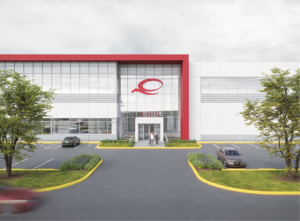





The window company will be joined by automotive parts manufacturer NVH Korea. This project will create over 160 new jobs and bring $72 million in investment to Henry County.
Rapid growth puts stress on infrastructure, and to ease the transition for these companies, the county established its first Community Improvement District – Locust Grove North. This self-taxing district allows private business owners to invest in local infrastructure and road improvement projects, says Fenn.
Another sign of local growth is the $250 million expansion of Piedmont Henry Hospital. The project adds a new patient tower with 95 new inpatient rooms and three additional surgery suites.
Expansions of medical services is driven “not just by population growth, but our job growth and the surge of our private-payer mix inside of Henry County,” says Fenn. “Jobs that we have brought here in the last few years really helped make the case for that [expansion].”
All these projects are a product of the economic growth sweeping across the South Metro region.
“Historically, we’ve been a supply-chain logistics center, but over the last four years, we’ve seen a significant increase in manufacturing,” says Fenn. “With the reshoring effort over the past few years, manufacturers have really been attracted to Henry County because of our location and being able to take advantage of the supply-chain infrastructure that we have here. It’s also driven by the growth of our workforce.”
In fact, Henry’s manufacturing job growth has been fourth in the state and fifth highest across all industries, says Fenn.
Scoring a Big Goal
South Metro’s broad appeal is evident in Fayette County, where project announcements range from data centers to a national soccer center.
U.S. Soccer is building its new national training center on a 200-acre site in Trilith, the residential and retail community designed around Trilith Studios – the largest film studio built from the ground up in the U.S.
The soccer federation chose this location due to easy access to the Atlanta airport and the diverse local community that offers a high quality of life, according to Niki Vanderslice, president and CEO of the Fayette County Development Authority.
“We are a very active soccer community with over 6,000 kids and adults playing soccer,” she says. “We’ve got a commitment to soccer that they recognize that was 40 years in the making.”
Fayette, like other South Metro counties, has also attracted another type of industry – data centers.
QTS recently acquired 600 acres of land on Fayetteville’s west side as the site for a new data center. The facility is expected to include 7 million square feet of office space and substations, according to published reports.
Adding Jobs and Companies
Neighboring Coweta County is “focused almost exclusively on advanced manufacturing; that’s kind of our sweet spot,” says Sarah Jacobs, president of the Coweta County Development Authority. “We’ve got really a strong existing industry manufacturing base, so we’re trying to build on that.”
The county added to that industrial base by landing FREYR Battery’s $2.6 billion clean-battery manufacturing plant. The project is expected to produce 724 jobs when fully operational in 2026, according to Jacobs.
More recently, the county was selected as the site for a Hyundai Industrial Co. manufacturing facility. The global auto parts supplier will create 100 new jobs and invest more than $24 million to retrofit an existing building to produce arm and head rests for original equipment manufacturers (OEMs), including Hyundai Motor Group’s Metaplant in Bryan County and Kia’s West Point plant.
In addition, Hitachi Construction Machinery Americas Inc. formalized plans to expand its current location in Coweta into a regional headquarters.
“So they’re adding 92 jobs and a capital investment of $33 million,” says Jacobs.
Vital New Hub
Like many other cities in South Metro, Forest Park is also updating its downtown.
“One of the projects that we’re currently working on is the redevelopment of the old Rite Aid building on Forest Parkway,” says Mayor Angelyne Butler. “We’re planning to turn that [building] into a culinary incubator. Forest Park is in need of more culinary experiences.”
The incubator is projected to include a bakery, coffee shop and as many as five other restaurants “to help make Forest Park more of a culinary attraction,” she says.
The city is making plans to transform Main Street with a series of mixed-use developments, she added.
“Clayton County is a supply chain and logistics hub and has been known for that … for quite a while, but we really saw during the pandemic just how important and vital these industrial companies are, not only to the local economy here, but to the Southeast and the world,” says Erica Rocker, Clayton County Economic Development officer.
The county is trying to build on these assets by “diversifying our economic portfolio,” she added. “We’ve got our lead industry sectors like food and beverage, transportation and distribution companies, warehouses and aviation-type companies. But we’re doing a concentrated business attraction effort to grow in the bioscience, biotech industry, research and development companies, because they do pay a higher [wage], even though it can still be seen as light industrial.”
One of the most recent additions is a manufacturing facility for GlassesUSA, one of the country’s largest online optical eyeglass makers.
“They established their headquarters here in Clayton County,” says Rocker.
The new facility will include 75 jobs and represents a $10 million investment in the construction of a “high-tech lab to fulfill these prescriptions,” she says. “So when you order your glasses and submit it online, there’s a very good chance that it’s coming right here to Clayton County, not just [for] the U.S. customer but [for] the world.”
The county is also finding new uses for old assets. Clayton County Schools broke ground on a $117 million student convocation center at Southlake Mall in Morrow. In addition to a 9,000-seat arena, the redevelopment will house the College and Career Academy and Junior Achievement programs.
Beyond academic uses, the facility offers space for conferences and business meetings, according to Clayton County Chamber of Commerce President Valencia Williamson.
These expanded facilities “[add] to the attractiveness of our community for surrounding and neighboring communities,” Williamson says.
The Clayton economy is changing and that holds promise for local residents.
“We’ve got a diverse workforce in terms of not just warehousing and distribution or manufacturing jobs, but we also have education, healthcare, aviation and others,” says Williamson. “There are other opportunities for our young people to grow and thrive.”
South Metro has become a region of rapid and sophisticated growth. With a diverse economy offering wide opportunities, the region is increasingly a top choice for businesses and workers alike.
Photography Woodie Williams and contributed
